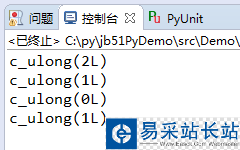本文实例讲述了Python引用计数操作。分享给大家供大家参考,具体如下:
为了简化内存管理,Python通过引用计数机制实现了自动的垃圾回收功能,Python中的每个对象都有一个引用计数,用来计数该对象在不同场所分别被引用了多少次。每当引用一次Python对象,相应的引用计数就增1,每当消毁一次Python对象,则相应的引用就减1,只有当引用计数为零时,才真正从内存中删除Python对象。
import ctypesdef get_ref(obj): """ returns a c_size_t, which is the refcount of obj """ return ctypes.c_size_t.from_address(id(obj))l = [1,2,3,4]l2 =ll_ref = get_ref(l)print l_refdel lprint l_refdel l2print l_refanother_list = [0, 0, 7]a_ref = get_ref(another_list)print a_ref
输出:
c_ulong(2L)
c_ulong(1L)
c_ulong(0L)
c_ulong(1L)
运行结果如下图所示:

另外python编译成字节码的模块为 dis
import dis # bytecode disassembler moduledef time_2(x): return 2 * xdis.dis(time_2)print "*"*20dis.dis(get_ref)
结合上述代码,测试示例如下:
import ctypesimport dis # bytecode disassembler moduledef get_ref(obj): """ returns a c_size_t, which is the refcount of obj """ return ctypes.c_size_t.from_address(id(obj))def time_2(x): return 2 * xdis.dis(time_2)print "*"*20dis.dis(get_ref)
运行结果:
7 0 LOAD_CONST 1 (2)
3 LOAD_FAST 0 (x)
6 BINARY_MULTIPLY
7 RETURN_VALUE
********************
5 0 LOAD_GLOBAL 0 (ctypes)
3 LOAD_ATTR 1 (c_size_t)
6 LOAD_ATTR 2 (from_address)
9 LOAD_GLOBAL 3 (id)
新闻热点
疑难解答